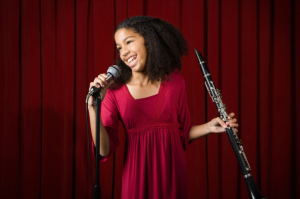‘Tis the season of gratitude! As we careen into the final months of the year, many of us find our minds turning toward the holidays and the opportunity to give thanks for the people, the moments and the good tidings that have enriched our lives this year.
That’s a very good thing, given new and new-ish scientific research that shows how actively appreciating what others do for us can strengthen our bonds with one another while making us healthier and happier.
Consider the findings of two university-based researchers, Giacomo Bono and Jeffrey Froh, who have explored the positive effects of gratitude on children and adolescents.
“…our research shows that grateful kids are happier, more satisfied with their relationships and school experiences, more pro-social, more committed to using their strengths to better their community, less envious, less depressed and less materialistic.”
– Jeffrey Froh, Ph.D., co-author, Making Grateful Kids
 Froh and Giacomo’s book, Making Grateful Kids: The Science of Building Character (2014), sums up the research in the new field the two are helping to expand. The book was written for adults who want to help kids cultivate an attitude of gratitude and reap promising psychological benefits.
Froh and Giacomo’s book, Making Grateful Kids: The Science of Building Character (2014), sums up the research in the new field the two are helping to expand. The book was written for adults who want to help kids cultivate an attitude of gratitude and reap promising psychological benefits.
Thriving Schools spoke with co-author Bono, who serves as director of the Positive Social Development and Dynamics Lab at California State University, Dominguez Hills. We asked Bono to define gratitude and characterize its significance for us.
“Gratitude is positively responding to beneficial social exchanges,” he said. “It’s interpersonal. It’s the emotion that helps us establish our own relationships in the world and very much a part of our autonomous development. We experience gratitude when we have a supportive community.”
Froh and Bono’s research findings are nicely articulated in a series of articles from The Greater Good Science Center (GGSC), a research center at the University of California, Berkeley, where faculty and graduate students study the psychology, sociology and neuroscience of well-being.
In their article for GGSC, How to Foster Gratitude in Schools, the authors propose three key principles for educators to keep in mind as they develop their own gratitude curriculum:
1. Notice intentions. Try to encourage students to appreciate the thought behind gifts they receive—to consider how someone noticed their need and acted on it. Research suggests this goes a long way toward cultivating “an attitude of gratitude” among children and adults alike.
2. Appreciate costs. We also find it important to emphasize that when someone is helpful, that person usually sacrifices time or effort to provide the help. For example, teachers could ask, “What are some things your friend gave up to help you with that project?”
3. Recognize the value of benefits. Teachers can also foster gratitude by reminding students that when others help us, they are providing us with “gifts.”
 Froh and Giacomo also offer ways to help students maximize the benefits of keeping a gratitude journal or making a gratitude visit, in which a student writes a letter to someone who has helped them, then reads the letter to that person.
Froh and Giacomo also offer ways to help students maximize the benefits of keeping a gratitude journal or making a gratitude visit, in which a student writes a letter to someone who has helped them, then reads the letter to that person.
“Anytime there is cooperation and teamwork, there’s a great opportunity for encouraging gratitude, helpfulness and appreciation,” explains Giacomo. He adds that at school, it helps to have highly creative visual reminders, such as a gratitude wall with artwork. “Celebrating the gifts they are grateful for can also help kids become more in touch with the silent heroes, everyone who makes school community great.”
The study of gratitude is still relatively new. But to these researchers, it’s anything but inconclusive.
“We have solid scientific evidence that these practices boost students’ moods, broaden their thinking and energize greater learning,” they write.
Is it possible that grateful kids eat more fruits and vegetables and have stronger immune systems? Bono says the evidence is accumulating. To stay abreast of the research and learn about practical applications for individuals and schools, look for a new website, Stay Grateful, in the early months of 2015.
You may also be interested to follow a three-year project of Greater Good Science Center and the University of California, Davis, on Expanding the Science and Practice of Gratitude, made possible by The John Templeton Foundation.




